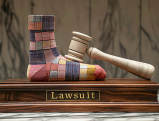
by Jonathan Schmig
May 11, 2015
Trademark protection in the U.S. requires three things: that the mark be distinctive; that the mark be nonfunctional; and that the mark be used in commerce. Obviously, there’s a lot to be said of all those topics, but for the purposes of this article, I’m going to focus on one specific part of just one of them: something called “acquired distinctiveness,” alternatively known as “secondary meaning.”
Basically, it’s a safety net. Trademarks require “distinctiveness”—that is, a valid trademark is one that can distinguish the good or service to which it is affixed from the goods or services of competitors. “Apple” for computers is a very distinctive mark because it’s random (but more on that in a bit), and you can easily distinguish between Apple, Inc.’s products and the products of rivals through the use of that “Apple” mark (the word or the logo).
But what to do when your mark isn’t objectively distinctive—something trademark law refers to as “inherently distinctive”—but still distinguishes your good or service from competitors? A good hypothetical example might be a company that sells “Pink Shoes,” a line of shoes that are pink. Objectively speaking, there’s nothing about that mark that may distinguish the company’s product from other companies selling pink-colored shoes. But if, over time, the public has nonetheless come to identify the term “Pink Shoes” with the products of that specific company, then it has become distinctive and has earned the ability to distinguish and identify source. This is secondary meaning.
A lot hinges on whether a mark has (or needs) secondary meaning. Many jurisdictions require very strong showings of secondary meaning in order to establish it. And that can be extremely difficult if the brand isn’t a famous one like McDonald’s or Wendy’s.
The Lanham Act (the Bible of U.S. trademark law) doesn’t define secondary meaning, but the Restatement (Third) of Unfair Competition does: a mark has achieved secondary meaning if, “as a result of its use, prospective purchasers have come to perceive it as a designation” that identifies the good or service. (§ 13.) By and large, the specifics of and tests for distinctiveness (along with functionality, and use) all derive from cases, not law.
The Lanham Act does have some reference to secondary meaning, most importantly in § 2, which details the types of marks that are prohibited from protection. Some prohibitions are absolute—§ 2(a) denies protection to “scandalous” or “disparaging” marks (think Redskins); § 2(b) denies protection to marks that are merely a country’s flag. But others are specifically exempted from such prohibition (by § 2(f)), if they can show they have “become distinctive.” The most important such exception (and by far the most litigated) is for marks that are “merely descriptive.”
Before diving into that, however, I would like to note three things. One is that there are multiple types of trademarks, including word marks, logo marks, and trade dress. I will discuss them separately, but the analysis can often bleed. Two, is that, in trademark law, the vital inquiry is something called the Primary Significance Test: what matters is that the public associates the mark with the producer, not the product. The mark must be capable of identifying source.
And three is that “secondary meaning,” more than many other aspects of trademark law (and IP law, and law in general), is very fact-specific. As you’re about to see, that is unfortunately the repeating theme of this article. There are very few brightline rules when it comes to analyzing secondary meaning, which has resulted in many courts applying slightly differing standards and frameworks to the cases that come before them.
That said, the Restatement (Third) of Unfair Competition does list a series of factors that most courts will consider to varying degrees. (§ 13, Comment (e).) These factors are split among two camps: either “direct evidence” (surveys, proof of actual consumer confusion, etc.) or “circumstantial evidence” (how long the mark has been in use, ads and promos that highlight the mark, etc.). However, direct evidence is often hard to come by (surveys are expensive, after all), so many cases will hinge on circumstantial factors like length of use and the defendant’s intent in implementing their allegedly infringing mark.
Word Marks
A word mark is a name or slogan. The name can be a business name or a product/service name. “Lego” is a company that sells toys; “Lego” is also the name of the toy that company sells. Competitors, therefore, are precluded from either naming their business “Lego” or from making a product called a “lego.”
In the U.S., the most authoritative case we have on the subject of distinctiveness in word marks is Abercrombie, which established the appropriately named “Abercrombie spectrum.” According to this spectrum, there are five categories a potential mark could fit into: generic; merely descriptive; suggestive; arbitrary; or fanciful. The first is obviously the worst. If a mark is “generic,” it cannot be protected as a trademark, period. (For example, a brand of beer called “Beer.”) Meanwhile, the latter three (suggestive, arbitrary, and fanciful) are all “inherently distinctive”: they are marks that are either random or made-up or simply not obvious, so that the mark owner doesn’t need to jump through any extra hoops in establishing whether it is “distinctive.” This would be “Apple” as applied to computers (but not “Apple” as applied to a business selling apples), or “Kodak,” or “Piggly Wiggly.”
The only category left, then—so-called “merely descriptive” marks—is the only one that deals with secondary meaning. A merely descriptive mark is basically exactly what it sounds like. It’s one step up from something “generic,” but not quite enough of a leap to get to “suggestive.” And since getting a mark deemed “inherently distinctive” is less burdensome than having to go through the rigmarole of proving “acquired distinctiveness,” any trademark owner would want their mark to be deemed suggestive, rather than merely descriptive.
But what, really, is the difference between the three? Simply put, no one knows. It’s one of degree. It’s fact-specific. The swing from suggestive down to merely descriptive and down further to generic is a quick and unclear one.
There is no hard and fast rule as to the proper classification under Abercrombie, but there is some guidance. One 5th Circuit case articulated four different tests that courts have used in trying to figure out if a mark was merely descriptive (and therefore would require a showing of secondary meaning) versus suggestive (and therefore wouldn’t). One such test is the “imagination test”: if the mark “requires imagination, thought, or perception” to connect the mark to the product (in the mind of the consumer), then it is probably suggestive, and not merely descriptive. Something like “Blu-Ray” or “Coppertone” would satisfy this test and be deemed suggestive.
Again, this is all highly fact-specific, and, worse, it’s all extremely important to determine. If a mark is deemed “generic” (and not “merely descriptive”), then it cannot be protected, regardless of what the public thinks; if a mark is deemed “merely descriptive” (and not “suggestive”), then it can only be protected by showing that the public identifies the mark with the specific producer, something many courts enforce by an arduous and rigorous standard.
Plus, there are many other factors that go into the analysis. Misspellings are not enough to “lift” a term from generic to merely descriptive (or merely descriptive to suggestive). “Lite” for a light beer, for instance, isn’t protectable. Nor is “Fish-Fri” for a fish fry.
Just because a mark is really just several otherwise generic marks put together, the new mark is not necessarily automatically generic as well. It could instead be “merely descriptive” (or better) as a combination. This is due to the anti-dissection rule in trademark, which generally holds that a mark must be assessed as a whole, and can’t be “picked apart” during analysis of whether it qualifies as valid.
Additionally, the U.S. has something called the “doctrine of foreign equivalents” when it comes to foreign words. A word mark is not “merely descriptive” or “suggestive” in the U.S. simply by virtue of being a word from another language. (Branding your beer “Cerveza,” for instance.) You must translate the meaning of the word into English to determine whether the mark is generic or not. The implication, however, is that if the mark is “merely descriptive” in the foreign language, even if the foreign jurisdiction does not utilize the Abercrombie spectrum, then it will be analyzed as such in the U.S.
Logos
Logos are trademarks that are capable of identifying the product/source without having to use words (although words may sometimes be a part of the logo). Logos, like word marks, can have “inherently distinctiveness” or “acquired distinctiveness,” or can be generic. However, the Abercrombie spectrum hasn’t worked as well in the realm of logos—how does one truly decide if a cartoon bear is “merely descriptive” versus “suggestive”?
For that reason, courts have looked elsewhere for guidance on the determination of logo distinctiveness. One 1977 case listed four factors to consider, including whether the logo was a “common shape” or basic design, and whether it was a mere decoration. But there wasn’t much guidance in figuring out whether secondary meaning was required. That case was more focused on whether inherent distinctiveness existed.
Amazing Spaces was one of many cases that tried to grapple with the question of secondary meaning in the context of logos. No test was articulated, but the (case-specific) factors led the court to the conclusion that the five-pointed star in a circle at issue in the case did not have acquired distinctiveness, in part because even though it had been in use for a long time and was even featured in ads, the ads never pointed specifically to the logo as a mark, but rather used the logo in a backseat role, as “decoration.” Nonetheless, the plaintiff in that case was also seeking trade dress protection, and the trade dress there was protectable, even though the isolated logo was not.
So then, what is trade dress?
Trade Dress
Trade dress is basically the overall visual impression or appearance of something that is capable of indicating source. That “something” can be a product package (e.g., detachable labels, or the box a product comes in), a product design (the design of a shoe, or guitar, or phone, or anything), or even a business’s “total look-and-feel” (like, for instance, the design of the building, the menu layout, the uniforms worn, etc.).
Two Pesos, a 1992 Supreme Court case, specifically held that “trade dress,” although not explicitly protected in the language of the Lanham Act, was nevertheless still protectable in trademark law. As a general matter, the case held that trade dress can sometimes be inherently distinctive (that is, it can sometimes be so distinctive that it does not require a showing of secondary meaning), and, in cases where the trade dress is not “inherently” distinctive, a showing of secondary meaning will satisfy the distinctiveness analysis.
But, since Two Pesos was virtually silent on any form of test as to determining whether a trade dress qualified as “inherently distinctive,” the courts were left to their own devices on that question. Moreover, Two Pesos did not deal with the far more contentious trade dress categories of product design and product packaging.
In 2000, the Supreme Court stepped in again and tried to address that. According to the Court, when a trade dress is product design, it can never be inherently distinctive, and, therefore, it must always show secondary meaning in order to be granted protection. In Justice Scalia’s opinion, “even the most unusual of product designs—such as a cocktail shaker shaped like a penguin—is intended not to identify source, but to render the product itself more useful or appealing.”
While some might debate the veracity of such a claim, the standard was at least unambiguous. And the implication is that product packaging may be inherently distinctive (but isn’t necessarily). The line between packaging and design is often very blurry—a Coke bottle may be “packaging” for the soda inside, or it may be “design” if the bottle itself is the thing being purchased (e.g., by a collector of soda bottles). Thus, the Supreme Court did at least give one more piece of advice: in close cases, courts should err on the side of product design, and therefore require a showing of secondary meaning.
Jurisdictions since have come up with a multitude of tests trying to figure out exactly when a product is “design” versus “packaging.” The question is still very up in the air, and, as with all secondary meaning issues, everything is fact-specific. But the holding that product design can never be inherently distinctive is not exactly a departure from precedent. An earlier Supreme Court case held that color, alone, can qualify for trademark protection, but that it can never be inherently distinctive. Scent marks and sound marks are similarly limited. The Lanham Act even expressly says that geographic marks and surname marks require a showing of secondary meaning.
But still, the question of “packaging” v. “design” is an extremely difficult one to answer. Plus, even if the product in question is deemed “packaging,” that doesn’t automatically circumvent the secondary meaning analysis. And that analysis is riddled with its own difficulties.
Take-Aways
Secondary meaning is required when your mark (whether word, logo, design, packaging, or something else) is not “inherently distinctive,” but also not “generic.” When it’s in that grey space, then you must show secondary meaning, by way of proving that the consuming public associates the mark with the producer, thereby proving that the mark as acquired distinctiveness.
But beyond that, even with the intermittent Supreme Court offerings, the test for determining when a mark requires a showing of secondary meaning (that is, when a mark is neither inherently distinctive nor generic) is hazy at best, and it differs among the types of protectable trademarks, and it differs from jurisdiction to jurisdiction. Worse, the test for determining whether a mark that needs secondary meaning has that secondary meaning is even less clear, and also differs among the types of trademarks, and also differs from jurisdiction to jurisdiction.
The only thing that is constant, seemingly, is that all secondary meaning cases are fact-specific. For what that’s worth.
Topics: Trademarks










